Spatial-Temporal Changes of Methane Content in the Atmosphere for Selected Countries and Regions with High Methane Emission from Rice Cultivation
Abstract
:1. Introduction
2. Materials and Methods
2.1. Study Area
2.2. Satellite Data
2.3. Data Analysis
3. Results
3.1. Methane Content by Country/Region
3.2. Temporal Changes in CH4 Content
3.3. Spatial-Temporal Variability in CH4 Content for Selected Countries/Regions
3.4. Relationships between Estimated GHG Emissions and CH4 Content
4. Discussion
5. Conclusions
Supplementary Materials
Author Contributions
Funding
Institutional Review Board Statement
Informed Consent Statement
Conflicts of Interest
References
- Song, P.; Mansaray, L.R.; Huang, J.; Huang, W. Mapping paddy rice agriculture over China using AMSR-Etime series data. ISPRS J. Photogramm. Remote Sens. 2018, 144, 469–482. [Google Scholar] [CrossRef]
- Zhang, B.; Tian, H.; Ren, W.; Tao, B.; Lu, C.; Yang, J.; Pan, S. Methane emissions from global rice fields: Magnitude, spatiotem-poral patterns, and environmental controls. Glob. Biogeochem. Cycles 2016, 30, 1246–1263. [Google Scholar] [CrossRef] [Green Version]
- Prasad, R.; Shivay, Y.S.; Kumar, D. Current Status, Challenges, and Opportunities in Rice Production. In Rice Production Worldwide; Chauhan, B., Jabran, K., Mahajan, G., Eds.; Springer: Cham, Switzerland, 2017; pp. 1–32. [Google Scholar]
- Zhang, G.; Xiao, X.; Dong, J.; Xin, F.; Zhang, Y.; Qin, Y.; Doughty, R.B.; Moore, B. Fingerprint of rice paddies in spatial–temporal dynamics of atmospheric methane concentration in monsoon Asia. Nat. Commun. 2020, 11, 554. [Google Scholar] [CrossRef] [PubMed] [Green Version]
- Singh, V.; Zhou, S.; Ganie, Z.; Valverde, B.; Avila, L.; Marchesan, E.; Bagavathiannan, M. Rice production in the Americas. In Rice Production Worldwide; Springer: Cham, Switzerland, 2017; pp. 137–168. [Google Scholar]
- Yodkhum, S.; Gheewala, S.H.; Sampattagul, S. Life cycle GHG evaluation of organic rice production in northern Thailand. J. Environ. Manag. 2017, 196, 217–223. [Google Scholar] [CrossRef] [PubMed]
- Boucher, O.; Friedlingstein, P.; Collins, B.; Shine, K.P. The indirect global warming potential and global temperature change potential due to methane oxidation. Environ. Res. Lett. 2009, 4, 044007. [Google Scholar] [CrossRef]
- Saunois, M.; Stavert, A.R.; Poulter, B.; Bousquet, P.; Canadell, J.G.; Jackson, R.B.; Zhuang, Q. The global methane budget 2000–2017. Earth Syst. Sci. Data 2020, 12, 1561–1623. [Google Scholar] [CrossRef]
- Jacob, D.J.; Turner, A.J.; Maasakkers, J.D.; Sheng, J.; Sun, K.; Liu, X.; Chance, K.; Aben, I.; McKeever, J.; Frankenberg, C. Satellite observations of atmospheric methane and their value for quantifying methane emissions. Atmos. Chem. Phys. 2016, 16, 14371–14396. [Google Scholar] [CrossRef] [Green Version]
- Schneising, O.; Buchwitz, M.; Reuter, M.; Bovensmann, H.; Burrows, J.P.; Borsdorff, T.; Deutscher, N.M.; Feist, D.G.; Griffith, D.W.T.; Hase, F.; et al. A scientific algorithm to simultaneously retrieve carbon monoxide and methane from TROPOMI onboard Sentinel-5 Precursor. Atmos. Meas. Tech. 2019, 12, 6771–6802. [Google Scholar] [CrossRef] [Green Version]
- Lorente, A.; Borsdorff, T.; Butz, A.; Hasekamp, O.; Schneider, A.; Wu, L.; Hase, F.; Kivi, R.; Wunch, D.; Pollard, D.F.; et al. Methane retrieved from TROPOMI: Improvement of the data product and validation of the first 2 years of measurements. Atmos. Meas. Tech. 2021, 14, 665–684. [Google Scholar] [CrossRef]
- Hu, H.; Hasekamp, O.; Butz, A.; Galli, A.; Landgraf, J.; Aan de Brugh, J.; Borsdorff, T.; Scheepmaker, R.; Aben, I. The operational methane retrieval algorithm for TROPOMI. Atmos. Meas. Tech. 2016, 9, 5423–5440. [Google Scholar] [CrossRef] [Green Version]
- Sha, M.K.; Langerock, B.; Blavier, J.F.L.; Blumenstock, T.; Borsdorff, T.; Buschmann, M.; Dehn, A.; De Mazière, M.; Deutscher, N.M.; Feist, D.G.; et al. Validation of Methane and Carbon Monoxide from Sentinel-5 Precursor using TCCON and NDACC-IRWG stations. Atmos. Meas. Tech. Discuss. 2021, 14, 6249–6304. [Google Scholar] [CrossRef]
- Zhao, R.; Li, Y.; Ma, M. Mapping Paddy Rice with Satellite Remote Sensing: A Review. Sustainability 2021, 13, 503. [Google Scholar] [CrossRef]
- Algorithm Theoretical Baseline Document for Sentinel-5 Precursor Methane Retrieval. Available online: https://sentinel.esa.int/documents/247904/2476257/Sentinel-5P-TROPOMI-ATBD-Methane-retrieval (accessed on 12 July 2021).
- Hu, H.; Landgraf, J.; Detmers, R.; Borsdorff, T.; Aan de Brugh, J.; Aben, I.; Butz, A.; Hasekamp, O. Toward global mapping of methane with TROPOMI: First results and intersatellite comparison to GOSAT. Geophys. Res. Lett. 2018, 45, 3682–3689. [Google Scholar] [CrossRef]
- FAOSTAT. FAOSTAT Food and Agriculture Organization of the United Nations. 2015. Available online: http://www.fao.org/faostat/ (accessed on 5 July 2021).
- Ramankutty, N.; Evan, A.T.; Monfreda, C.; Foley, J.A. Farming the planet: 1. Geographic distribution of global agricultural lands in the year 2000. Glob. Biogeochem. Cycles 2008, 22, 1–19. [Google Scholar] [CrossRef]
- EarthStat. Available online: http://www.earthstat.org/ (accessed on 24 June 2020).
- Google Earth Engine. Sentinel-5P OFFL CH4 Image Collection. Available online: https://developers.google.com/earth-engine/datasets/catalog/COPERNICUS_S5P_OFFL_L3_CH4 (accessed on 24 June 2020).
- QGIS Development Team. Geographic Information System. Open Source Geospatial Foundation Project. 2016. Available online: http://www.qgis.org/ (accessed on 5 July 2021).
- Carlson, K.M.; Gerber, J.S.; Mueller, N.D.; Herrero, M.; MacDonald, G.K.; Brauman, K.A.; Havlik, P.; O’Connell, C.S.; Johnson, J.A.; Saatchi, S.; et al. Greenhouse gas emissions intensity of global croplands. Nat. Clim. Chang. 2017, 7, 63–68. [Google Scholar] [CrossRef]
- STATISTICA (Data Analysis Software System), v. 10; StatSoft, Inc.: Tulsa, OK, USA, 2010; Available online: www.statsoft.com (accessed on 5 July 2021).
- Maasakkers, J.D.; Jacob, D.J.; Sulprizio, M.P.; Scarpelli, T.R.; Nesser, H.; Sheng, J.X.; Zhang, Y.; Hersher, M.; Bloom, A.A.; Bowman, K.W.; et al. Global distribution of methane emissions, emission trends, and OH concentrations and trends inferred from an inversion of GOSAT satellite data for 2010–2015. Atmos. Chem. Phys. 2019, 19, 7859–7881. [Google Scholar] [CrossRef] [Green Version]
- Global Monitoring Laboratory. Trends in Atmospheric Methane. Global CH4 Monthly Means. 2021. Available online: https://gml.noaa.gov/ccgg/trends_ch4/ (accessed on 12 July 2021).
- Dalsøren, S.B.; Myhre, C.L.; Myhre, G.; Gomez-Pelaez, A.J.; Søvde, O.A.; Isaksen, I.S.; Weiss, R.F.; Harth, C.M. Atmospheric me-thane evolution the last 40 years. Atmos. Chem. Phys. 2016, 16, 3099–3126. [Google Scholar] [CrossRef] [Green Version]
- Nisbet, E.G.; Manning, M.R.; Dlugokencky, E.J.; Fisher, R.E.; Lowry, D.; Michel, S.E.; Lund, M.C.; Platt, S.M.; Allen, G.; Bousquet, P.; et al. Very strong atmospheric methane growth in the 4 years 2014–2017: Implications for the Paris Agreement. Glob. Biogeochem. Cycles 2019, 33, 318–342. [Google Scholar] [CrossRef]
- Crevoisier, C.; Nobileau, D.; Armante, R.; Crépeau, L.; Machida, T.; Sawa, Y.; Matsueda, H.; Schuck, T.; Thonat, T.; Pernin, J.; et al. The 2007–2011 evolution of tropical methane in the mid-troposphere as seen from space by MetOp-A/IASI. Atmos. Chem. Phys. 2013, 13, 4279–4289. [Google Scholar] [CrossRef] [Green Version]
- Shelley, I.J.; Takahashi-Nosaka, M.; Kano-Nakata, M.; Haque, M.S.; Inukai, Y. Rice cultivation in Bangladesh: Present scenario, problems, and prospects. J. Int. Coop. Agric. Dev. 2016, 14, 20–29. [Google Scholar]
- Adhya, T.K.; Mishra, S.R.; Rath, A.K.; Bharati, K.; Mohanty, S.R.; Ramakrishnan, B.; Rao, V.R.; Sethunathan, N. Methane efflux from rice-based cropping systems under humid tropical conditions of eastern India. Agric. Ecosyst. Environ. 2000, 79, 85–90. [Google Scholar] [CrossRef]
- Zhang, Y.; Su, S.; Zhang, F.; Shi, R.; Gao, W. Characterizing spatiotemporal dynamics of methane emissions from rice paddies in northeast China from 1990 to 2010. PLoS ONE 2012, 7, e29156. [Google Scholar] [CrossRef] [PubMed] [Green Version]
- Uddin, K.; Matin, M.A.; Meyer, F.J. Operational flood mapping using multi-temporal sentinel-1 SAR images: A case study from Bangladesh. Remote Sens. 2019, 11, 1581. [Google Scholar] [CrossRef] [Green Version]
- Parvin, M.; Begum, A. Organic solid waste management and the urban poor in Dhaka city. Int. J. Waste Resour. 2018, 8, 2. [Google Scholar] [CrossRef]
- Harris, J.M.; Tans, P.P.; Dlugokencky, E.J.; Masarie, K.A.; Lang, P.M.; Whittlestone, S.; Steele, L.P. Variations in atmospheric methane at Mauna Loa Observatory related to long-range transport. J. Geophys. Res. Atmos. 1992, 97, 6003–6010. [Google Scholar] [CrossRef]
- Schuck, T.J.; Ishijima, K.; Patra, P.K.; Baker, A.K.; Machida, T.; Matsueda, H.; Sawa, Y.; Umezawa, T.; Brenninkmeijer, C.A.M.; Lelieveld, J. Distribution of methane in the tropical upper troposphere measured by CARIBIC and CONTRAIL aircraft. J. Geophys. Res. Atmos. 2012, 117, 1–14. [Google Scholar] [CrossRef] [Green Version]
- Chakraborty, M.; Sharma, C.; Pandey, J.; Singh, N.; Gupta, P.K. Methane emission estimation from landfills in Delhi: A com-parative assessment of different methodologies. Atmos. Environ. 2011, 45, 7135–7142. [Google Scholar] [CrossRef]
- Yan, X.; Cai, Z.; Ohara, T.; Akimoto, H. Methane emission from rice fields in mainland China: Amount and seasonal and spa-tial distribution. J. Geophys. Res. Atmos. 2003, 108, 4505. [Google Scholar] [CrossRef]
- Barré, J.; Aben, I.; Agustí-Panareda, A.; Balsamo, G.; Bousserez, N.; Dueben, P.; Engelen, R.; Inness, A.; Lorente, A.; McNorton, J.; et al. Systematic detection of local CH4 anomalies by combining satellite measurements with high-resolution forecasts. Atmos. Chem. Phys. 2021, 21, 5117–5136. [Google Scholar] [CrossRef]
- Butz, A.; Galli, A.; Hasekamp, O.; Landgraf, J.; Tol, P.; Aben, I. TROPOMI aboard Sentinel-5 Precursor: Prospective performance of CH4 retrievals for aerosol and cirrus loaded atmospheres. Remote Sens. Environ. 2012, 120, 267–276. [Google Scholar] [CrossRef]
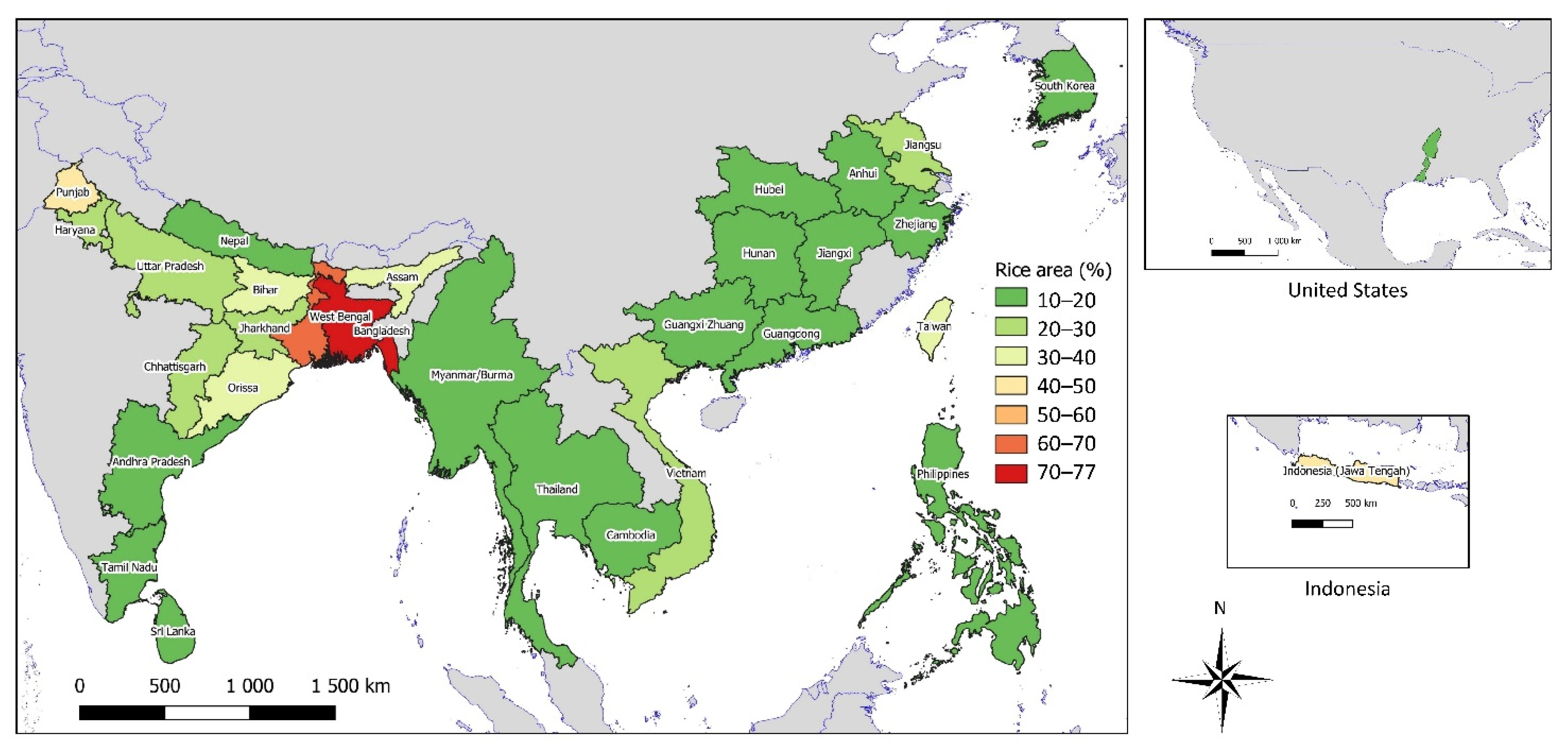
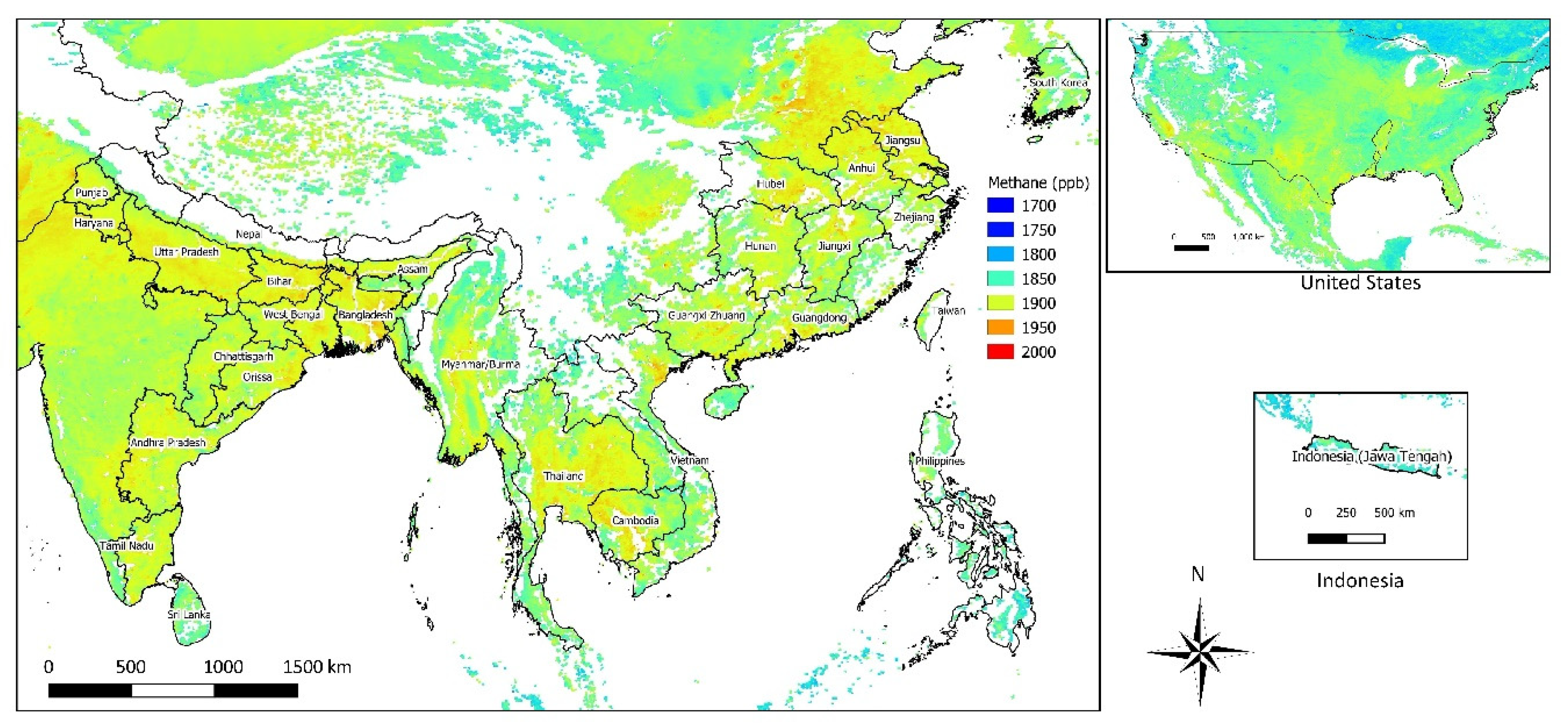
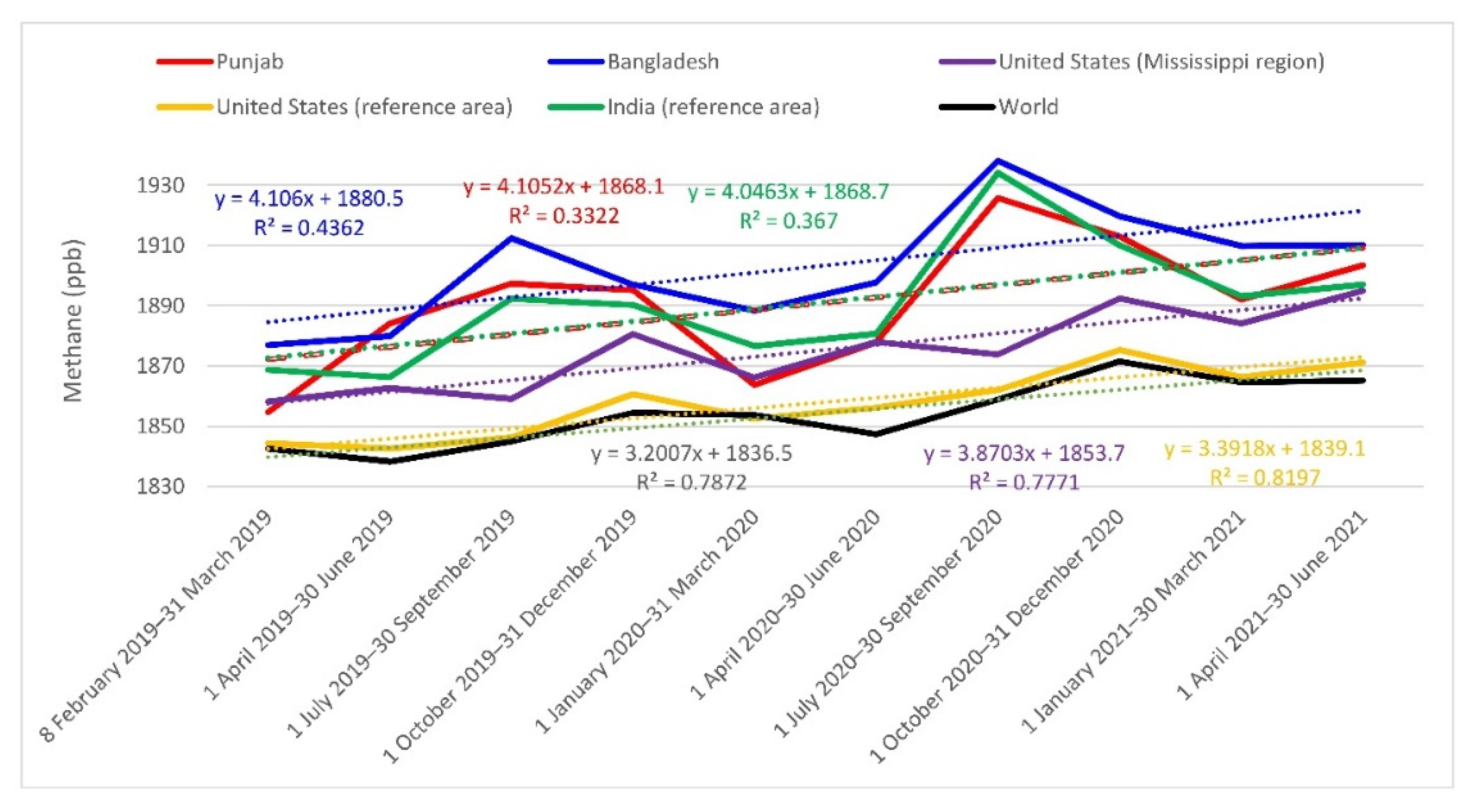
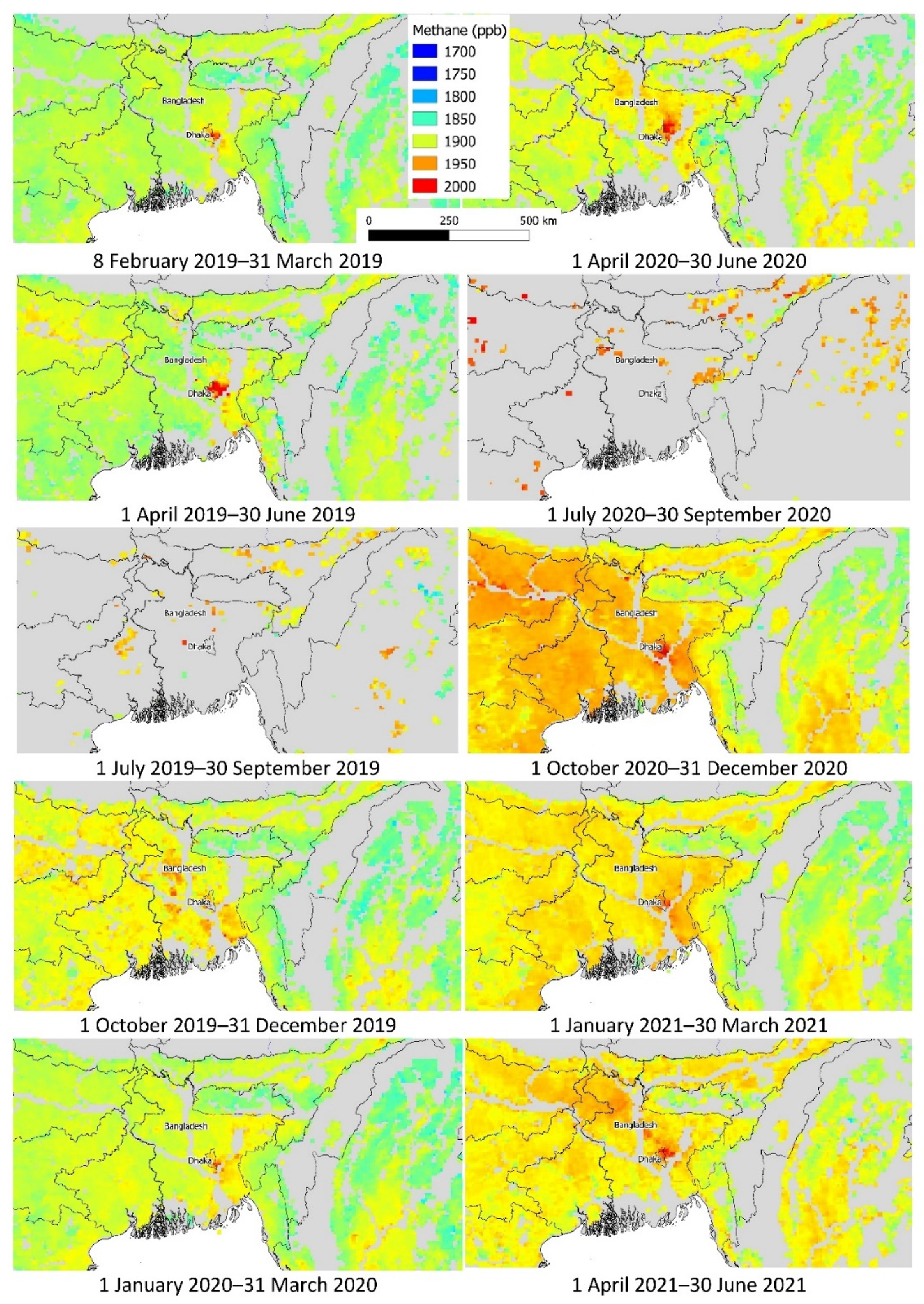
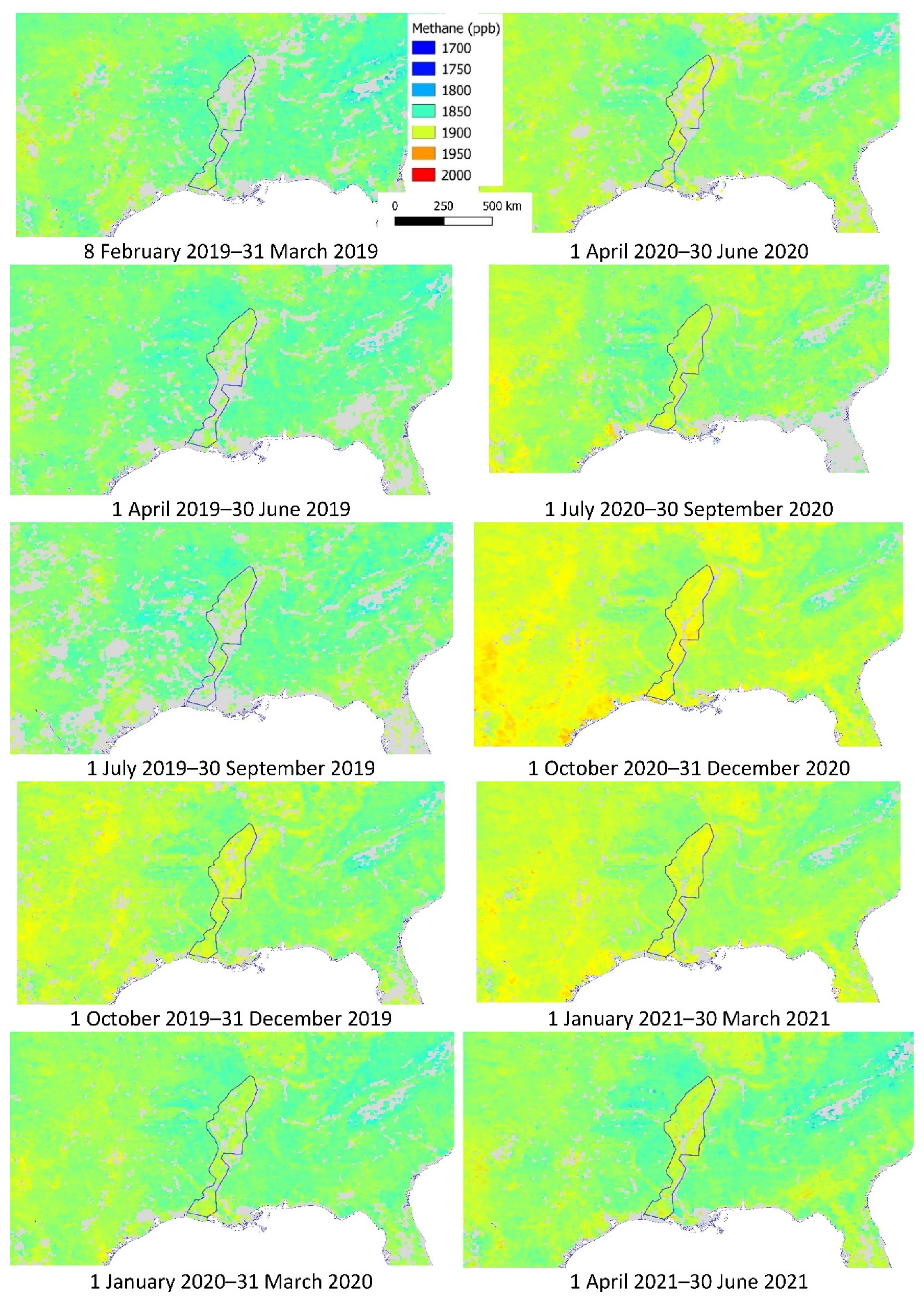


| Country/Region | Country | CH4 Content in Atmosphere (ppb) | Estimated GHG Emissions from Croplands (Mg CO2e Per Hectare) * | Mean Correlation | Min. Correlation | Max. Correlation |
|---|---|---|---|---|---|---|
| Zhejiang | China | 1886 | 4.12 | 0.28 | 0.16 | 0.43 |
| Jiangxi | China | 1887 | 3.84 | 0.02 | −0.03 | 0.06 |
| Hubei | China | 1892 | 3.09 | 0.79 | 0.77 | 0.81 |
| Anhui | China | 1897 | 3.26 | −0.38 | −0.47 | −0.25 |
| Jiangsu | China | 1904 | 3.25 | −0.49 | −0.53 | −0.41 |
| Hunan | China | 1886 | 4.04 | 0.62 | 0.57 | 0.68 |
| Guangxi Zhuang | China | 1889 | 3.16 | 0.27 | 0.20 | 0.36 |
| Taiwan | China | 1878 | 2.16 | 0.43 | −0.20 | 0.76 |
| Guangdong | China | 1889 | 3.58 | −0.54 | −0.61 | −0.48 |
| Andhra Pradesh | India | 1894 | 2.09 | −0.30 | −0.40 | −0.21 |
| Assam | India | 1893 | 2.04 | 0.25 | 0.13 | 0.39 |
| Bihar | India | 1903 | 3.16 | −0.53 | −0.76 | −0.41 |
| Chhattisgarh | India | 1889 | 2.53 | 0.37 | 0.18 | 0.68 |
| Haryana | India | 1898 | 2.42 | −0.66 | −0.82 | −0.53 |
| Jharkhand | India | 1895 | 1.65 | 0.17 | 0.06 | 0.23 |
| Orissa | India | 1893 | 2.74 | 0.35 | 0.28 | 0.44 |
| Punjab | India | 1895 | 4.21 | 0.48 | 0.24 | 0.77 |
| Tamil Nadu | India | 1893 | 2.00 | −0.11 | −0.37 | 0.17 |
| Uttar Pradesh | India | 1901 | 2.15 | −0.20 | −0.25 | −0.11 |
| West Bengal | India | 1901 | 3.79 | 0.42 | 0.34 | 0.52 |
| Jawa Tengah (Indonesia) | 1836 | 8.77 | 0.14 | 0.08 | 0.17 | |
| Mississippi region (USA) | 1884 | 1.69 | 0.36 | −0.02 | 0.68 | |
| Bangladesh | 1903 | 3.56 | −0.27 | −0.44 | −0.10 | |
| Sri Lanka | 1863 | 5.41 | 0.25 | −0.15 | 0.70 | |
| Cambodia | 1889 | 2.47 | 0.52 | 0.45 | 0.60 | |
| South Korea | 1872 | 6.40 | −0.06 | −0.22 | 0.16 | |
| Myanmar/Burma | 1877 | 1.16 | 0.37 | 0.35 | 0.38 | |
| Nepal | 1890 | 1.73 | 0.63 | 0.22 | 0.85 | |
| Philippines | 1853 | 1.76 | 0.59 | 0.04 | 0.78 | |
| Thailand | 1889 | 3.40 | 0.42 | 0.16 | 0.53 | |
| Vietnam | 1877 | 7.51 | 0.24 | 0.18 | 0.31 | |
| Country/Region | Country | 8 February–31 March 2019 | 1 April–30 June 2019 | 1 July–30 September 2019 | 1 October–31 December 2019 | 1 January–31 March 2020 | 1 April–30 June 2020 | 1 July–30 September 2020 | 1 October–31 December 2020 | 1 January–31 March 2021 | 1 April–30 June 2021 | Linear Regression |
|---|---|---|---|---|---|---|---|---|---|---|---|---|
| Zhejiang | China | 1862 | 1871 | 1900 | 1888 | 1865 | 1877 | 1904 | 1898 | 1882 | 1901 | y = 2.9·x + 1868.9 |
| Jiangxi | China | 1864 | 1879 | 1901 | 1879 | 1865 | 1886 | 1909 | 1900 | 1882 | 1907 | y = 3.1·x + 1870.0 |
| Hubei | China | 1863 | 1881 | 1910 | 1885 | 1871 | 1890 | 1915 | 1907 | 1886 | 1907 | y = 3.2·x + 1873.9 |
| Anhui | China | 1868 | 1879 | 1904 | 1891 | 1873 | 1887 | 1926 | 1912 | 1889 | 1907 | y = 3.5·x + 1874.3 |
| Jiangsu | China | 1870 | 1877 | 1906 | 1896 | 1876 | 1883 | 1926 | 1913 | 1893 | 1911 | y = 3.7·x + 1874.7 |
| Hunan | China | 1859 | 1868 | 1904 | 1881 | 1862 | 1883 | 1900 | 1905 | 1883 | 1902 | y = 3.5·x + 1865.3 |
| Guangxi Zhuang | China | 1857 | 1845 | 1909 | 1881 | 1861 | 1876 | 1901 | 1903 | 1882 | 1895 | y = 3.9·x + 1859.7 |
| Taiwan | China | 1856 | 1848 | 1890 | 1874 | 1859 | 1944 | 1887 | 1889 | 1885 | y = 4.7·x + 1855.8 | |
| Guangdong | China | 1865 | 1845 | 1907 | 1880 | 1864 | 1875 | 1925 | 1898 | 1886 | 1891 | y = 3.7·x + 1862.9 |
| Andhra Pradesh | India | 1876 | 1870 | 1859 | 1907 | 1882 | 1887 | 1884 | 1919 | 1900 | 1904 | y = 4.3·x + 1865.4 |
| Assam | India | 1877 | 1878 | 1904 | 1880 | 1879 | 1889 | 1912 | 1899 | 1897 | 1904 | y = 2.7·x + 1877.0 |
| Bihar | India | 1867 | 1887 | 1893 | 1898 | 1879 | 1888 | 1964 | 1933 | 1907 | 1909 | y = 5.6·x + 1871.8 |
| Chhattisgarh | India | 1867 | 1867 | 1843 | 1886 | 1873 | 1878 | 1912 | 1907 | 1891 | 1896 | y = 5.0·x + 1854.3 |
| Haryana | India | 1851 | 1888 | 1895 | 1893 | 1866 | 1884 | 1933 | 1920 | 1889 | 1903 | y = 4.4·x + 1867.8 |
| Jharkhand | India | 1869 | 1873 | 1888 | 1890 | 1879 | 1881 | 1918 | 1899 | 1903 | y = 4.0·x + 1868.0 | |
| Orissa | India | 1870 | 1866 | 1853 | 1891 | 1878 | 1877 | 1928 | 1913 | 1898 | 1899 | y = 5.4·x + 1857.9 |
| Punjab | India | 1855 | 1884 | 1897 | 1895 | 1864 | 1878 | 1926 | 1913 | 1892 | 1903 | y = 4.1·x + 1868.1 |
| Tamil Nadu | India | 1872 | 1872 | 1845 | 1919 | 1881 | 1888 | 1857 | 1910 | 1903 | 1891 | y = 3.3·x + 1865.9 |
| Uttar Pradesh | India | 1863 | 1885 | 1904 | 1895 | 1875 | 1887 | 1941 | 1928 | 1897 | 1904 | y = 4.4·x + 1873.4 |
| West Bengal | India | 1875 | 1872 | 1913 | 1897 | 1885 | 1885 | 1947 | 1925 | 1909 | 1906 | y = 4.5·x + 1876.8 |
| Jawa Tengah (Indonesia) | 1817 | 1825 | 1831 | 1838 | 1833 | 1834 | 1845 | 1840 | 1859 | 1850 | y = 3.6·x + 1817.2 | |
| Mississippi region (USA) | 1858 | 1863 | 1859 | 1881 | 1866 | 1878 | 1874 | 1892 | 1884 | 1895 | y = 3.9·x + 1853.7 | |
| Bangladesh | 1877 | 1880 | 1912 | 1897 | 1888 | 1898 | 1938 | 1920 | 1910 | 1910 | y = 4.1·x + 1880.5 | |
| Sri Lanka | 1851 | 1835 | 1819 | 1874 | 1864 | 1849 | 1836 | 1877 | 1877 | 1869 | y = 3.7·x + 1834.6 | |
| Cambodia | 1863 | 1849 | 1866 | 1878 | 1873 | 1861 | 1853 | 1891 | 1894 | 1879 | y = 3.0·x + 1854.3 | |
| South Korea | 1849 | 1854 | 1876 | 1865 | 1854 | 1864 | 1875 | 1885 | 1873 | 1883 | y = 3.2·x + 1850.0 | |
| Myanmar/Burma | 1860 | 1867 | 1888 | 1871 | 1869 | 1880 | 1916 | 1890 | 1881 | 1892 | y = 3.3·x + 1863.5 | |
| Nepal | 1856 | 1872 | 1885 | 1879 | 1863 | 1876 | 1976 | 1904 | 1894 | 1898 | y = 5.6·x + 1859.2 | |
| Philippines | 1848 | 1846 | 1834 | 1859 | 1860 | 1856 | 1846 | 1871 | 1872 | 1878 | y = 3.5·x + 1837.5 | |
| Thailand | 1865 | 1862 | 1918 | 1885 | 1880 | 1882 | 1874 | 1898 | 1895 | 1882 | y = 1.5·x + 1875.7 | |
| Vietnam | 1851 | 1854 | 1901 | 1879 | 1864 | 1867 | 1898 | 1901 | 1882 | 1878 | y = 3.1·x + 1860.6 | |
| India (reference area) | 1869 | 1866 | 1892 | 1890 | 1877 | 1881 | 1934 | 1910 | 1893 | 1897 | y = 4.0·x + 1868.7 | |
| China (reference area) | 1838 | 1850 | 1871 | 1871 | 1860 | 1860 | 1884 | 1884 | 1868 | 1879 | y = 3.6·x + 1846.5 | |
| United States (reference area) | 1844 | 1843 | 1846 | 1861 | 1853 | 1856 | 1862 | 1875 | 1866 | 1871 | y = 3.4·x + 1839.1 | |
Publisher’s Note: MDPI stays neutral with regard to jurisdictional claims in published maps and institutional affiliations. |
© 2021 by the authors. Licensee MDPI, Basel, Switzerland. This article is an open access article distributed under the terms and conditions of the Creative Commons Attribution (CC BY) license (https://creativecommons.org/licenses/by/4.0/).
Share and Cite
Kozicka, K.; Gozdowski, D.; Wójcik-Gront, E. Spatial-Temporal Changes of Methane Content in the Atmosphere for Selected Countries and Regions with High Methane Emission from Rice Cultivation. Atmosphere 2021, 12, 1382. https://doi.org/10.3390/atmos12111382
Kozicka K, Gozdowski D, Wójcik-Gront E. Spatial-Temporal Changes of Methane Content in the Atmosphere for Selected Countries and Regions with High Methane Emission from Rice Cultivation. Atmosphere. 2021; 12(11):1382. https://doi.org/10.3390/atmos12111382
Chicago/Turabian StyleKozicka, Katarzyna, Dariusz Gozdowski, and Elżbieta Wójcik-Gront. 2021. "Spatial-Temporal Changes of Methane Content in the Atmosphere for Selected Countries and Regions with High Methane Emission from Rice Cultivation" Atmosphere 12, no. 11: 1382. https://doi.org/10.3390/atmos12111382
APA StyleKozicka, K., Gozdowski, D., & Wójcik-Gront, E. (2021). Spatial-Temporal Changes of Methane Content in the Atmosphere for Selected Countries and Regions with High Methane Emission from Rice Cultivation. Atmosphere, 12(11), 1382. https://doi.org/10.3390/atmos12111382







